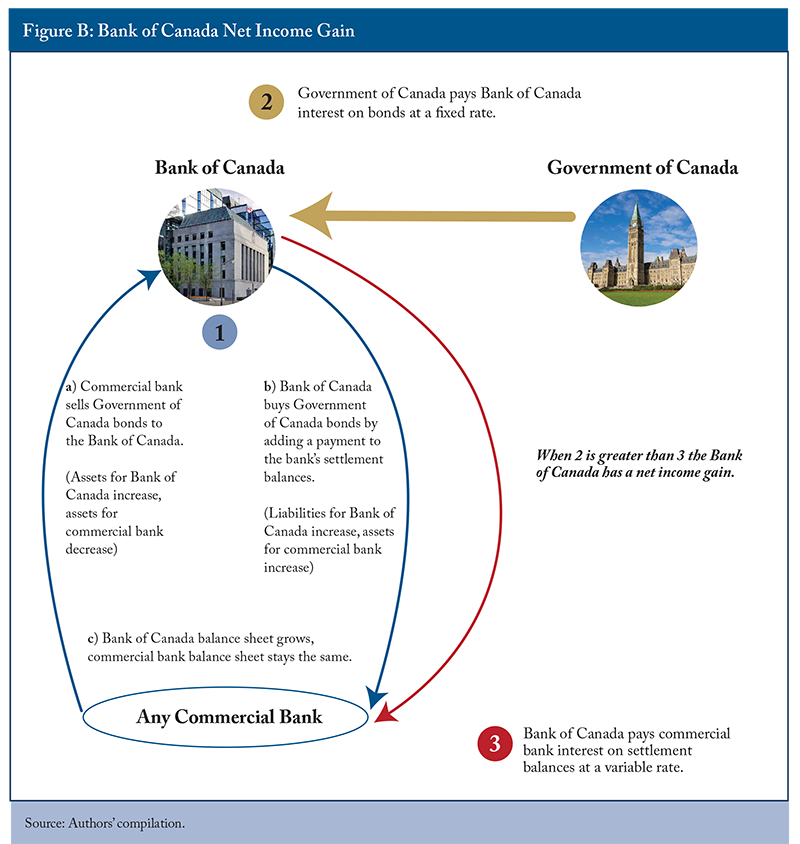The Study In Brief
The Bank of Canada’s balance sheet has undergone a radical transformation since the beginning of the pandemic. The Bank’s total assets more than quadrupled at their peak and still remain 3.5 times higher. The most radical change on the liabilities side has been the increase in settlement balances held by financial institutions at the Bank as part of its large-value payment system. The reason: more bonds on the Bank’s balance sheet have been matched with increases to the settlement balances of the banks who sold them.
In this Commentary, we explore the consequences for the Bank of Canada of an enlarged balance sheet. Structural changes such as the introduction of new payments systems and new means of payments – Lynx, the new large-value system, the real time rail (RTR) on the retail side, and the possible introduction of a central bank digital currency – all have the potential to increase the demand for the use of settlement balances. Further, the Bank’s decision to hold its large holdings of federal debt, accumulated through asset purchases, until they mature will perpetuate excess settlement balances for the foreseeable future.
As a consequence, the Bank of Canada announced that it will not return for now to its traditional corridor system around the policy rate, or target overnight rate, but will instead continue to run a floor system to implement monetary policy. With excess settlement balances in their Bank of Canada accounts, financial institutions have little need to lend to each other in the course of business each day, driving the overnight rate down to the Deposit Rate the Bank pays on settlement balances, which forms the floor.
The upside of an elevated balance sheet is that it will facilitate real time settlement under the modernized payment systems since financial institutions have ample liquidity. The downside is that the Bank of Canada will necessarily hold a larger share of Government of Canada bonds on the asset side of its balance sheet. While the Bank can employ repos and security lending to limit its impact on market functioning, by following its current strategy of quantitative tightening while also holding bonds to maturity and acting as a large holder of Government of Canada debt, it will still affect equilibrium interest rates in the economy.
This may raise concerns about the independence of the Bank of Canada from the government. We argue that the indemnity agreement signed by the Bank and government in early 2020 protects the Bank from a negative equity position due to valuation losses on the bonds. It is not, however, applicable to the Bank’s operational losses as a result of the sharp rise in the policy interest rate that by now means that the interest the Bank is paying on settlement balances exceeds the interest earned on the Government of Canada debt it owns. These losses are likely to leave the Bank in a negative equity position.
Such a scenario could undermine the independence of the Bank of Canada in the eyes of the public. We therefore suggest amending the Bank of Canada Act in order to allow the Bank of Canada to create a deferred asset to cover the operational losses. That way the Bank formally has no negative equity arising from operational losses and must use future profits to pay down the entire deferred asset before remitting profits to the government, thereby compensating for current losses. This will enable the Bank to credibly communicate its current strategy of quantitative tightening, in particular making clear that it is in line with its aggressive tightening of the overnight rate to achieve the 2 percent inflation target in the near future.
The authors thank Daniel Schwanen, Alexandre Laurin, Charles DeLand, Edward Devlin, David Longworth, Angelo Melino, Trevor Tombe, Mark Zelmer and anonymous reviewers for helpful comments on an earlier draft. The authors retain responsibility for any errors and the views expressed.
Introduction
During the recent pandemic, the Bank of Canada intervened rapidly by cutting its overnight rate target to its effective lower bound in March 2020 and by introducing a number of asset purchasing programs to stabilize financial markets.
Over the next few months, its balance sheet ballooned quickly from a size of just over $120 billion in early March 2020 to a peak of $575 billion in March 2021. This increase was largely a consequence of the Bank’s quantitative easing (QE) program, which bought up Government of Canada debt across the yield curve, to provide further stimulus to the economy.
On the liabilities side of the balance sheet, those assets were mostly paid for by increasing the settlement balances held by financial institutions at the Bank of Canada. (See Key Concept Explainer on next page.) Such settlement balances increased by three orders of magnitude, from $250 million to approximately $260 billion, implying a massive excess supply of short-term liquidity for Canada’s financial system.
With settlement balances so high as a result of QE, there has been little to no demand for short-term funding in the overnight market. As a result, the Bank of Canada cannot operate its traditional corridor system any longer where – in the absence of large settlement balances – financial institutions allocate short-term funding close to the target for the overnight rate. Instead, the Bank now operates what is called a floor system where interest rates in the overnight market are close to the Deposit Rate paid to banks for their balances at the Bank of Canada.
Against this background, this Commentary looks at the issues that will drive the size of the Bank of Canada’s balance sheet in the short, medium and long runs. It also discusses the challenges Canada’s central bank faces when operating with a large balance sheet.
The short run developments in the balance sheet are driven entirely by the Bank’s current monetary policy tightening strategy to rein in high inflation. The Bank of Canada has begun to increase interest rates aggressively while employing quantitative tightening (QT). With respect to the latter measure, it has decided to simply let maturing government debt roll off its balance sheet rather than actively selling it to the market. Hence, its balance sheet will only gradually decline and settlement balances will remain fairly large for the foreseeable future.
In the medium run, developments in payments will place upward pressure on the Bank’s balance sheet. In September 2021, the Lynx system replaced the Large Value Transfer System (LVTS) as the main electronic wire payments system for transferring funds between large financial institutions. Similarly, despite recent delays, real-time retail payments via the real time rail (RTR) are to be introduced in due time. Both will operate as a real-time gross settlement (RTGS) model, where transactions settle immediately, and as a result there are pressures for financial institutions to handle additional liquidity needs. While some features in these new payments system are designed to temper such needs, there will most likely be a moderate increase in the demand for settlement balances.
There is also the possible introduction of a central bank digital currency (CBDC).
However, it is also plausible to expect that the overall demand for public money will increase, leading to an expansion of central bank liabilities. One reason is simply that access to public money for the general public may become easier in the form of digital cash. Another reason is that the Bank of Canada may issue a wholesale version of digital cash in the form of a stablecoin linked to the loonie that would directly support financial markets. In such a scenario, liabilities would increase with stablecoin issuance akin to settlement balances.
It is unlikely, however, that the demand for settlement balances due to these developments in the payment system will outpace the supply. For these reasons, the Bank of Canada will operate in the long run with a significant amount of excess settlement balances. As a result, the floor system for implementing monetary policy will remain in place for the foreseeable future, which the Bank of Canada has officially – and rightly so – acknowledged.
What are the benefits and the costs of running such a system? The upside of the floor system is that it improves payment system functionality. It eases the settling of transactions in real time given the ample liquidity in the overnight market arising from excess settlement balances. While the Bank should naturally limit itself to the purchase of Government of Canada debt from banks in exchange for these settlement balances, there are concerns associated with holding an increased amount of government securities.
First, as a large player in the market, the Bank of Canada has greater influence over market interest rates for government debt as liquidity in markets becomes thinner. Such concerns, however, can be alleviated by engaging in short term repo and securities lending as the Bank of Canada has done in the recent past. Second, and more importantly, holding a larger amount of government debt – as currently under its current strategy of QT – makes the Bank potentially vulnerable to political interference.
The Bank of Canada signed an indemnity agreement with the federal government at the start of its asset purchase program in the second quarter of 2020 to insulate its balance sheet from possible future valuation losses. If the Bank were to sell these assets before they mature, this indemnity agreement adds to the operating expenses on the Government of Canada’s statement of operations, possibly triggering an extra need for the government to issue more debt.
But the agreement helps to keep the Bank from falling into a negative equity position by adding an asset (a derivative position) to the balance sheet that compensates for the valuation losses from the Bank’s Government of Canada debt holdings. Such a negative equity position – while not compromising the Bank’s ability to perform monetary policy – could potentially lead to pressure to re-capitalize the Bank, again causing the government to issue more debt. Indeed, allowing the Bank to operate with negative equity for an extended period of time may undermine the Bank’s credibility and set up expectations that it may be forced to increase seigniorage (profits from issuing currency) in order to build up its equity position.
The Bank therefore needs to explain clearly the details of how its indemnity agreement with the Government of Canada functions, and that it will not impact in any way its monetary policy decisions to achieve the 2 percent inflation target.
Similarly, the Bank and the Department of Finance should at a minimum explain how the Bank will deal with potential operational losses from the interest they are paying on settlement balances, which now exceeds the interest earned on the Government of Canada debt they own (See Appendix). If losses exceed the Bank’s relatively small equity and reserve positions, future Bank profits need to be split between replenishing equity and reserves and making transfers to the government.
A better option and, indeed, our preferred one is to follow the practice of the US Federal Reserve, which books operational losses as deferred assets on its balance sheet. This deferred asset is paid off from future profits before returning any surpluses to the Treasury. While such an arrangement would require a change to the Bank of Canada Act, it would be transparent enough for the Bank to convey to the public, signaling its continuing independence.
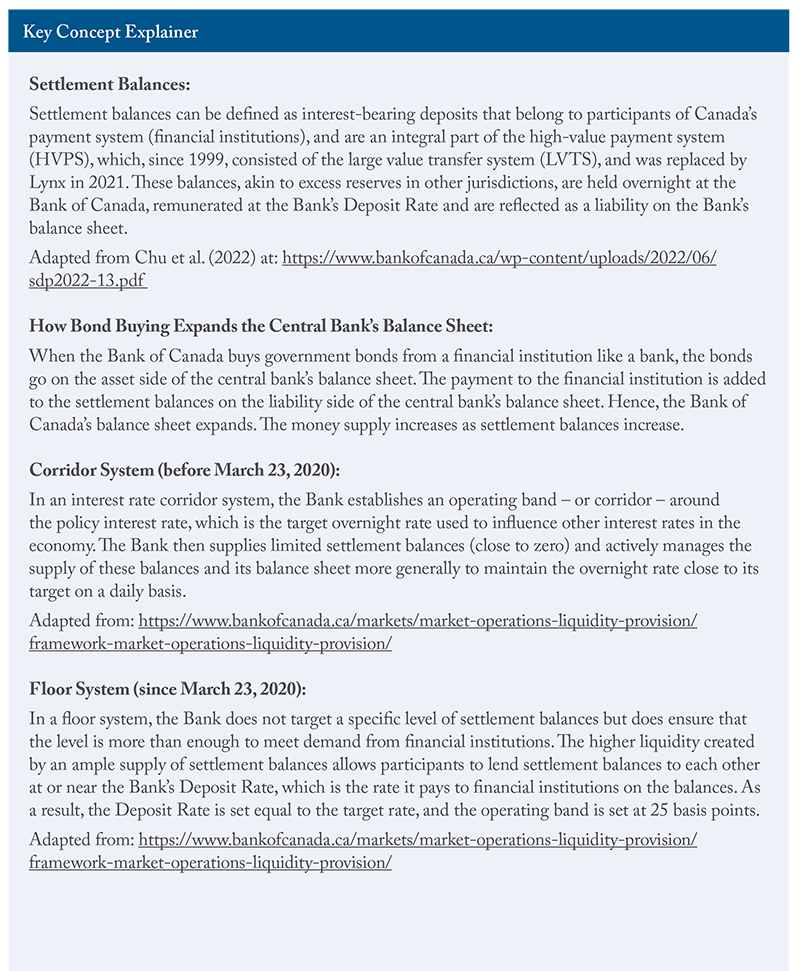
The Evolution of the Bank’s Balance Sheet during the Pandemic
The Bank of Canada’s response to the onset of the pandemic in 2020 was swift and decisive. Between March 4 and March 27, the Bank lowered the overnight rate target in three fifty-basis-point steps from 1.75 percent to 0.25 percent, its effective lower bound. Only the first cut on March 4 coincided with a fixed announcement date while the others were unconventional in the sense that they occurred at other dates.
Because the economic shutdowns imposed by the federal and most provincial governments threatened to turn into a full-blown financial crisis, the Bank also initiated several asset purchase programs to boost liquidity and to support critical financial markets. For the first time, it purchased large quantities of assets other than federal government debt, including provincial and private-sector debt. The Bank’s policies were largely successful in calming financial markets.
On March 27, the Bank inaugurated its Government of Canada Bond Purchase Program. Its initial goal was to address strains in this market by purchasing federal government bonds of different maturities in primary and secondary markets, as well as to “enhance the effectiveness of all other actions taken so far.”
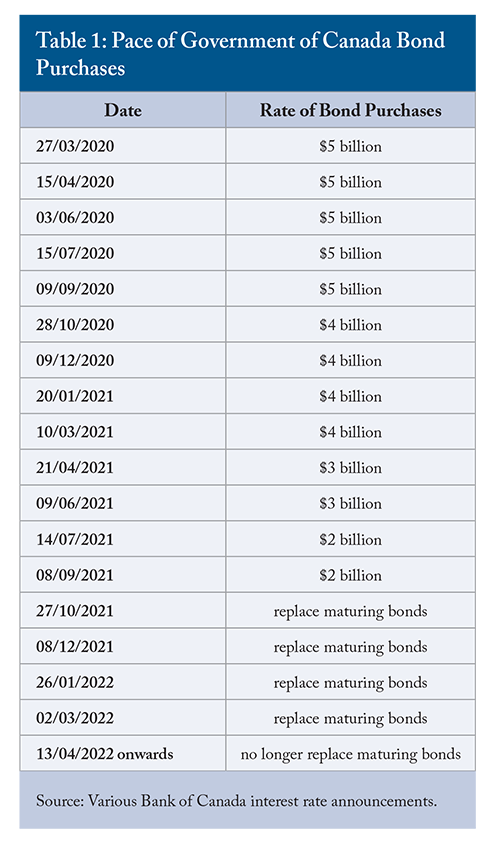
During the time the overnight rate target was at its lower bound, the intended pace of these purchases became a prominent feature of the Bank’s regular fixed announcement dates, which take place at six-week intervals. Its pace of purchases continued at $5 billion per week until the end of October 2020, and gradually reduced from then on until stopping altogether in October 2021. Table 1 gives the details of the Bank’s pace of bond purchases. As of the time of writing, the Bank has shifted to quantitative tightening (QT). For now, it will allow bonds that mature to roll off its balance sheet, shrinking it accordingly.
The Bank’s other asset purchasing programs have largely been wound down. By the end of 2021, it eliminated its holdings of provincial money market securities, commercial paper and bankers’ acceptances; by the end of 2022, it will have also eliminated all remaining term repos. It continues to hold a modest amount of corporate bonds, provincial bonds and Canada mortgage bonds. Most of the expansion of the Bank’s asset holdings (see Table 2) is due to its purchases of Government of Canada debt.
The Bank’s holdings of Government of Canada debt were just over $437 billion at the end of 2021 compared to a little less than $64 billion before the pandemic in December 2019 (captured as part of “Investments”). The total amount of Government of Canada debt outstanding at the end of 2021 was approximately $1.117 trillion.
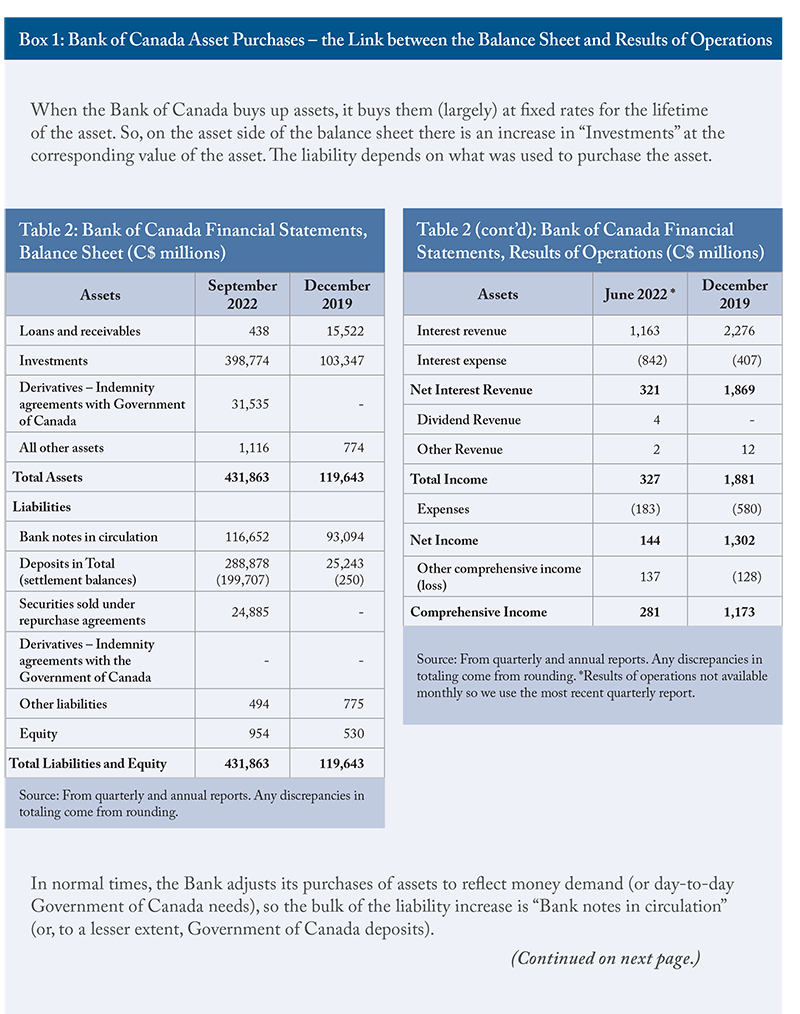
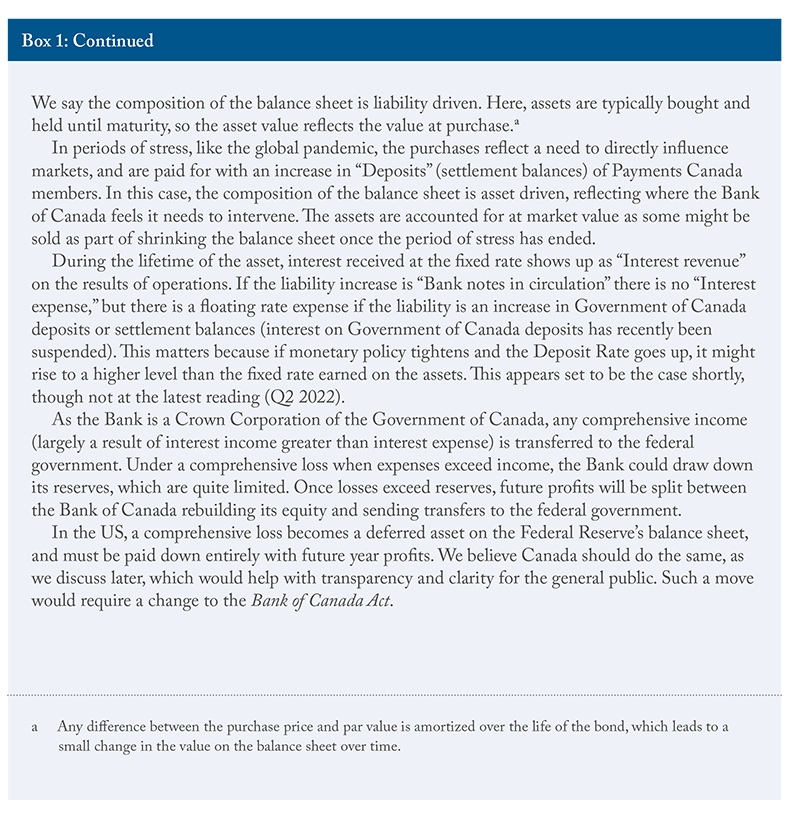
There remain two questions relevant to our analysis:
- What happens under QT if the Bank decides it needs to sell assets at a loss (as interest rates have increased)?
- How does the indemnity agreement signed between the Government of Canada and Bank of Canada change this story?
First, if the Bank decides to sell an asset before it matures, the asset side of the balance sheet will shrink with a corresponding fall in settlement balances of the financial institution that purchased the bond.
In normal times, as mentioned in Box 1, most of the Bank’s assets are held to maturity and are, therefore, accounted for as amortized cost (i.e., at the value when purchased). To deal with issues such as seasonal demand, the Bank will use repurchase agreements (repos), or acquire treasury bills and other short-term assets, “that mature when the seasonal demand for bank notes is expected to abate” (Johnson and Zelmer 2007).
Things are different in exceptional periods. If the Bank were to sell an asset for a loss as part of QT, the assets would shrink by a correspondingly smaller amount, as would the settlement balances from the financial institution that bought the bonds (the assets are at fair market value so the smaller amount is already baked in). However, with the indemnity agreement the Government of Canada signed with the Bank of Canada in the second quarter of 2020 – which shows up on the balance sheet as “Derivatives – Indemnity agreements with Government of Canada” – if the asset is in a loss, the loss shows up as an asset. This is because when the sale occurs, the Government of Canada transfers the corresponding loss amount to the Bank of Canada. Therefore, overall, the balance sheet shrinks by the same amount it would if the Bank of Canada let the asset mature and the asset was priced at its amortized cost.
Without the indemnity agreement, when the value of the asset shrank there would have to be an offsetting liability as the Bank was holding the asset. This offsetting liability would be a shrinking of the equity position. The latter is fine unless the Bank were to go into a negative equity position. In theory, the Bank could operate with a negative equity position, but this could lead to a gradual loss of credibility. As a result, it is possible that political pressure would force the government to inject new capital to boost equity, which would entail simultaneously issuing debt that the Bank of Canada would buy to create an offsetting boost to the asset side of the balance sheet.
How does the indemnity agreement show up on the Government of Canada’s financial statements?
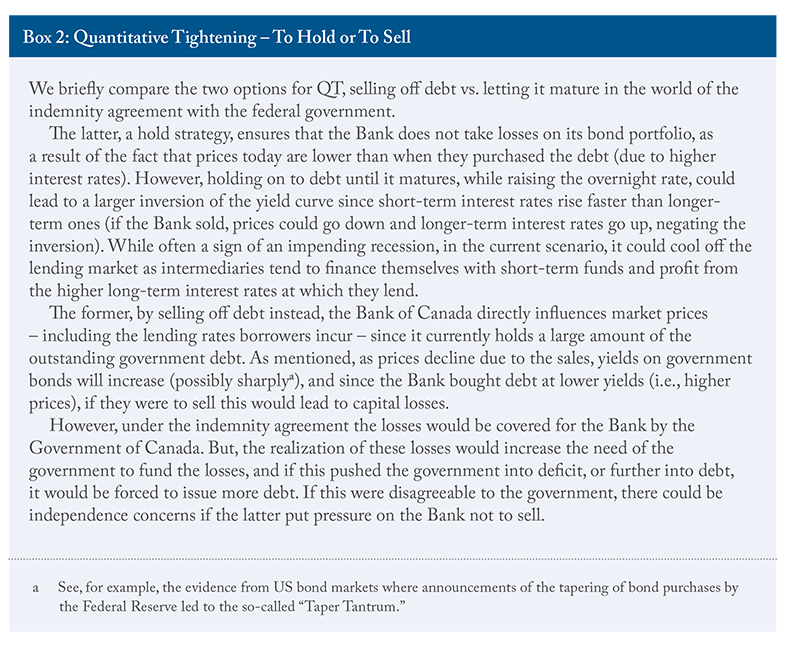
The Short-term: Unwinding Monetary Stimulus
As pointed out, once the overnight rate hits what the Bank of Canada considers its lower bound of 25 basis points, monetary policy can provide additional stimulus through purchases of federal government debt (and other assets). Known as QE, the additional stimulus this provides arises because by purchasing debt, the Bank of Canada is able to lower yields across the yield curve. This is intended to make borrowing cheaper for households and firms as intermediaries and financial markets price their lending activities off the government yield curve.
In 2022, faced with high inflation, the Bank of Canada started removing monetary stimulus from the economy. It has started to sharply increase the overnight rate and has reversed its QE program – known as QT. At the extremes, for the latter, the Bank has two options available. It can either hold the bonds and let them roll off the balance sheet as they mature or actively sell its portfolio. The trade-off between the two options mainly revolves around the arguments of managing the yield curve and safe-guarding the independence of the Bank (see Box 2 for a brief discussion).
The Bank of Canada has chosen the hold strategy. Due to the composition of the Bank’s portfolio,
The “hold-until-maturity” strategy is likely to cause little disruption in financial markets. Therefore, one can expect that the Bank of Canada will operate for some time with a significantly larger balance sheet than before the pandemic. Interestingly, a larger balance sheet than pre-pandemic may be necessary, regardless of QT strategy, as structural changes in the payment system take place that will require banks to hold additional liquidity; i.e., higher settlement balances. We turn to these structural changes next.
The Medium Term: Changes in the Payment System
The payment system has undergone or will undergo two fundamental changes. First, Canada has embarked on a modernization of its payment infrastructure. The new large value payment system, Lynx, has just come online and, while the real-time retail payments system via the real time rail (RTR) has been recently delayed, it is expected to launch soon.
Second, financial markets are undergoing a technological revolution that is based on the use of distributed ledgers and the use of digital currencies. These revolutions – often labelled as crypto economics and Decentralized Finance (DeFi), respectively – will possibly require infrastructure in the form of a digital currency provided by the central bank, or CBDC. We discuss next why both changes are likely to require that the Bank of Canada runs a larger balance sheet.
Payments System Reform – Lynx and RTR
In 1999, Canada launched the Large Value Transfer System (LVTS), an electronic-wire system allowing financial institutions to send large payments in a secure fashion in real time, with a guarantee of settlement. Payments processed under LVTS occurred in real time, while inter-bank settlement for the bulk of transactions only occurred at the end of the day.
In September 2021, the LVTS system was replaced by Lynx, owned and operated by Payments Canada with oversight by the Bank of Canada. In many respects, Lynx is a modernized version of LVTS, allowing for more data-rich payments, which helps support newer products and services for customers and digitizes outdated manual and paper-based invoicing and payments reconciliation. One of the primary differences between Lynx and LVTS is that the former is purely a real-time gross settlement system while in the latter settlement mainly occurred on a net basis end of day.
With Lynx, a participant – i.e., a financial institution with an account at the Bank of Canada – needs to have funds in the system to settle payments, making it essentially a pre-funded, large value payment system. In principle, this implies an increased demand for settlement balances by participants to fund their daily payments. The design of the system employs several mechanisms, however, to reduce the extra demand for liquidity. These liquidity saving mechanisms use the queuing of non-critical payments and participants can pledge eligible collateral against a “haircut” to obtain intraday credit.
Rivadeneyra and Zhang (2022) have performed simulation exercises to arrive at the modest amount of additional settlement balances that are required in the system to have only short delays in payments execution. The delay in payments arises for two reasons. First, participants bear an opportunity cost when pledging collateral or holding settlement balances. Second, a lack of coordination among participants – including the Bank of Canada – when scheduling payments can also lead to delays. Depending on the behaviour of participants and the use of different payment mechanisms in Lynx, Rivadeneyra and Zhang (2022) peg the impact at roughly $20 billion additional settlement balances at worst with average delays of less than one hour.
Such delays are, of course, less likely to occur whenever there are ample extra settlement balances in the system as is currently the case. Participants in Lynx hold an immense amount of settlement balances ($192 billion at the time of writing), making funding payments a non-issue. It is still an open question how participants will change their behaviour as settlement balances fall over time and what payment delay – and, hence, the minimum required settlement balances – Lynx should accept in an optimal design of the system.
On the retail side, the planned RTR payments system will provide 24/7/365 final and immediate settlement of retail payments. Such functionality requires funds to be available for all participants to settle their claims in this system. Since settlement ultimately occurs on the accounts of the Bank of Canada, funding needs to be ensured even when Lynx, which only operates during limited hours, is not available. This is also likely to increase the demand for settlement balances.
Research by Chu et al. (2022) points out as well that “[t]he optimal level of required settlement balances will depend on participants’ behaviour as they determine payment flows through the new system. It will also depend on the addition of new participants, given RTR’s broader access.” The increase that these new payments rails will require is therefore hard to gauge. The current amount of settlement balances is likely many times the amount required in the long run to ensure the proper functioning of these new payment systems. However, it is also fair to say that the average settlement balances prior to the pandemic, a mere $250 million during normal times, is likely insufficient to support Lynx and the planned RTR.
The second structural force that could keep the balance sheet elevated is the potential introduction of a central bank digital currency (CBDC) by the Bank of Canada. We note that at present, “The Bank currently has no plans to launch a CBDC. Rather, the Bank will build the capacity to issue a general purpose, cash-like CBDC should the need to implement one arise” (Bank of Canada 2020).
As the digital economy deepens, one area of innovation is around cryptocurrencies and the emergence of DeFi. Cryptos can be thought of as another form of private money, much like commercial bank deposits today, where transactions are verified and recorded using a decentralized system rather than the more standard centralized system involving financial institutions and the Bank of Canada. Such developments might force the Bank’s hand, consistent with their stated position that “[t]he Bank will consider launching a CBDC if certain scenarios materialize or appear as if they are likely to. A CBDC could become beneficial or even necessary, if…one or more alternative digital currencies – likely issued by private sector entities – were to become widely used as an alternative to the Canadian dollar as a method of payment, store of value and unit of account” (Bank of Canada 2020).
Similarly, DeFi
Central banks have been forced to ask themselves what the implications are for the financial system and for independent domestic monetary policy. If a cryptocurrency – especially one linked to a foreign currency – were to be used widely in Canada as a medium of exchange and to denominate contracts in Canada, monetary policy would be restricted as it may lose its ability to control the money supply. DeFi may need an infrastructure in order to reap its full benefits. Consequently, many central banks including the Bank of Canada have looked into issuing a digital currency either on the retail or wholesale level.
On the retail side,
The wholesale side presents a different dimension. DeFi relies on so-called stablecoins that use high quality assets as backing, possibly including reserves.
Some of this increase to the balance sheet might be offset because of what a CBDC means for settlement balances. The increased demand by the public for Bank of Canada liabilities would show up in “Notes in Circulation” (see Table 2) or an equivalent category representing digital cash. But, to the extent financial institutions see lower deposits as people demand more public cash in the form of CBDC, they would either need to replace those liabilities on their balance sheet or shrink assets. Part of the decision will depend on liquidity requirements, which require a certain amount of high-quality liquid assets (which settlement balances are) as a percentage of total assets and a certain amount of available stable funding (of which retail deposits are the most stable) as a percentage of required stable funding. To the extent shrinking settlement balances does not put banks into regulatory trouble, that might be a logical and less disruptive place to start. What this means is that while the Bank’s balance sheet will likely increase, there might be some offsetting effect from shrinking settlement balances.
In conclusion, medium-term trends are likely to increase the size of the balance sheet, with at least some of the increase coming in the form of a higher demand for settlement balances. Given its current QT strategy, however, the Bank of Canada will still operate with a large excess in settlement balances for the foreseeable future. Financial institutions in Canada will thus continue to be in a net credit position with the central bank. This will have ramifications for how the Bank of Canada implements its monetary policy, which we discuss next.
The Long-term: Monetary Policy Implementation
Traditionally, the Bank of Canada has operated a corridor system when implementing monetary policy. In a corridor system, the Bank sets its overnight rate target at the midpoint of a band of 50 basis points.
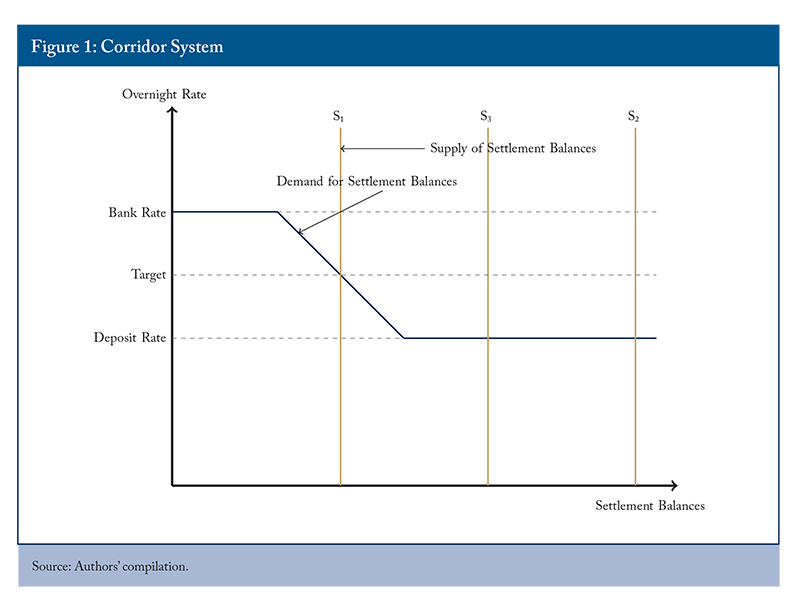
There is a clear link in this system between the overnight rate and the level of settlement balances as shown in Figure 1.
As settlement balances continue to increase, the overnight rate will drop towards the Deposit Rate at the bottom of the operating band. Eventually these increases become such that it is impossible to sustain an overnight rate above the Deposit Rate.
This is precisely what happened during the pandemic when the Bank of Canada bought Government of Canada bonds from financial institutions in secondary markets. In essence, an overnight rate target above the Deposit Rate became untenable, forcing the central bank to set the two equal to each other. This system of monetary policy is called a floor system.
But note that demand can change too, and what we argued in the medium-run section is there will be upward pressure on demand for settlement balances. The exact size of this increase in demand is unclear, but with the current size of the balance sheet, and the hold-to-maturity QT strategy, we believe supply will still be in the elastic zone, moving from a position like S2 to a position like S3.
This will leave the Bank with little choice other than to run a floor system. Hence, we will next evaluate the benefits and costs of such a system.
The immediate benefit of a floor system – and, indeed, more of a consequence – is that it gives the Bank of Canada an additional policy tool in the form of QE/QT.
The main benefit of a floor system, however, has to do with payments systems. As described above, modern real-time systems require participants to hold liquidity in the form of settlement balances or by pledging collateral. In a corridor system, liquidity is expensive, since the Deposit Rate institutions earn is below the overnight rate in the money market, meaning they would prefer to lend than to keep balances on deposit. Hence, participants have an incentive to delay payments or rely on pledging costly collateral for intraday liquidity, such as under the old LVTS system.
With the introduction of Lynx and the RTR, as mentioned, settlement has to be in real-time requiring participants to hold more liquidity. This is costly for participants, but a floor system eliminates these costs by making liquidity for payments purposes essentially free. As a consequence, operating a real-time gross settlement (RTGS) system becomes costless and, hence, efficient.
Another benefit of the floor system, which is more a challenge of running a corridor system using RTGS, is the varying demand for settlement balances across time under the modernized payments system. Such varying demand makes it hard for the Bank to set the supply of settlement balances under the corridor system that ensures the overnight rate is at target. Under the floor system, the Bank of Canada could simply supply large enough settlement balances to avoid excessive day-to-day management.
Potential Costs of the Floor System
In our view, the main concern with the floor system seems to be that it could interfere with the independence and credibility of the central bank.
There are two main arguments. First, the elevated balance sheet needed to run a floor system exposes the Bank of Canada to interest rate risk which is relevant in today’s context.
The capital loss is covered by the indemnification agreement the Bank signed with the government of Canada in 2020. According to the agreement, the government compensates the Bank for capital losses on its holdings of federal government bonds. That said, the independence concern arises because if the government has to compensate the Bank for losses upon sale, it will be an incurred expense for the government, which could force the issuance of more debt. As a result, the government might put pressure on the Bank to hold the assets to maturity, which may not be optimal for the conduct of monetary policy.
With respect to operational loss, the concern comes once the difference between interest income and interest expense becomes negative, meaning no transfers to the government, and, more importantly, losses for the Bank. The Bank could first draw down its reserves, but this is unlikely to be sufficient given the potential magnitude of losses.
Second, if running a floor system requires large settlement balances, the Bank of Canada may be forced to consider a broader set of assets than federal government securities. This would put the Bank squarely in credit allocation territory, as it would look for debt from lower levels of government, as well as highly rated private sector debt.
This would not seem to be a big issue since, even with an increased demand for settlement balances in the future, the current balance sheet is large enough so that we still have excess reserves. And, as we saw in Table 2, the assets supporting this excess are essentially all federal government debt.
A key question that remains, however, is whether a floor system and large holdings of government assets disrupt market signals.
Government debt plays an important role as collateral in financial markets, and is used as a reference point for pricing other debt instruments. This puts a limit on the percentage of federal debt the Bank of Canada should hold on its balance sheet in order not to distort the market. Here, should these limits be reached, the Bank will have to conduct reverse repo operations – temporarily selling back securities against settlement balances – and securities lending operations to reduce its impact.
In a related context, under the floor system the overnight rate market largely disappears, as does to a certain extent the short-term repo market. Less activity in this market means less monitoring of financial institutions’ activity in general, which might lead to a less sound banking system, one that is less robust to shocks. Whether this is critical in the Canadian context is unclear. After all, our financial institutions are well regulated and the market is fairly concentrated, so that market discipline seems to remain well maintained under the floor system.
Conclusion and Policy Implications
The Bank of Canada has made the decision to let the government bonds it accumulated during the pandemic slowly roll off its balance sheet as they mature. This approach, as opposed to actively selling the bonds, means the balance sheet will stay larger with excess settlement balances for the foreseeable future.
New structural changes in payments systems, and the potential introduction of a CBDC, imply that the demand for those settlement balances will increase as well. These changes to demand, however, are unlikely to fully reduce the excess supply of balances in the medium-run. Referring back to Figure 1, the downward-sloping part of the demand for settlement balances is gradually shifting to the right as the supply curve is shifting to the left. They will eventually meet, but not for some time. As a consequence, monetary policy will have to continue operating under a floor system. We do not see this as a big problem as there are benefits to doing so, and the costs can be mitigated.
The main challenge for the Bank is to figure out what the appropriate size of its balance sheet will be in the medium run given the implications of holding a large market share of Government of Canada debt. This involves two main research questions. First, what will the demand for settlement balances be as a consequence of the introduction of Lynx and the RTR? Second, if a CBDC is introduced, how much will the net demand for the Bank’s liabilities increase?
In the meantime, the key to moving forward will be to find ways to minimize the risks for the Bank of Canada of holding a large balance sheet. First, holding a larger balance sheet means playing a more significant role in the market for Government of Canada debt and potentially affecting rates of return that influence other market interest rates. Second, a hold-QT strategy invokes independence concerns if the reasons for its use are tied to the fact that selling bonds at a loss would increase expenses on the Government of Canada’s statement of operations, which could trigger the need for more debt.
The Bank needs to explain clearly how its indemnity agreement with the Government of Canada works, and how this is likely to affect its monetary policy decisions.
The Bank and the Department of Finance should also clearly explain how the Bank will deal with operational losses not covered by the indemnity agreement. Our recommendation here would be for Finance to accept deferred transfers, and for the Bank to resume remitting profits to the government only after it has paid off the deferred asset. Formally, this would require a change to the Bank of Canada Act, which we believe is not a significant barrier.
Our recommendations are relatively easy to implement and will address concerns about the independence of the Bank of Canada. They will also enable the Bank to credibly communicate its current QT strategy, in that it is in line with its aggressive tightening of the overnight rate to achieve the 2 percent inflation target in the near future.
Appendix: How the Bank of Canada Loses or Gains on its Holdings of Government of Canada Bonds
When the Bank of Canada buys Government of Canada bonds from commercial banks, it adds them to the asset side of its balance sheet and pays for them by adding to the banks’ deposits (settlement balances) on the liability side of its balance sheet. Amid rising interest rates, the variable interest it pays banks on those deposits exceeds the average of the fixed rate it earns on the bonds from the Government of Canada. The Bank incurs a net income loss (Figure A). When the reverse is true, the Bank has a net income gain (Figure B).
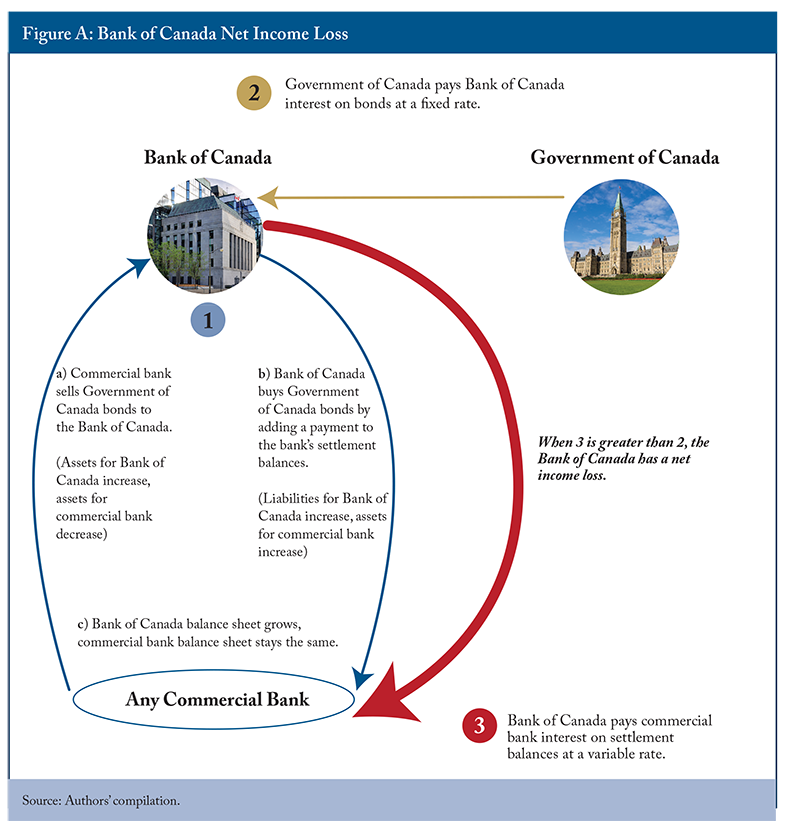
References
Ambler, Steve, and Jeremy Kronick. 2018. Navigating Turbulence: Canadian Monetary Policy since 2004. Toronto: Renouf Publishers for C.D. Howe Institute.
__________. 2020. “Canadian Monetary Policy in the Time of COVID-19.” E-Brief 307. Toronto: C.D. Howe Institute.
__________. 2020b. “Fiscal dominance would hobble the Bank of Canada.” Financial Post December 17. https://financialpost.com/opinion/opinion-fiscal-dominance-would-hobble-the-bank-of-canada
__________. 2021. For the Record: Assessing the Monetary Policy Stance of the Bank of Canada. Commentary 588. Toronto: C.D. Howe Institute.
Andolfatto, David. 2017. “A Public Finance Case for Keeping the Fed’s Balance Sheet Large.” Macromania Blog, February 15. https://andolfatto.blogspot.com/2017/02/a-public-finance-case-for-keeping-feds.html
__________. 2017a. “A Reply to Lawrence White.” Macromania Blog, March 1. https://andolfatto.blogspot.com/2017/03/a-reply-to-lawrence-white.html?spref=tw
Arjani, Neville, and Darcey McVanel. 2006. “A Primer on Canada’s Large Value Transfer System.” Draft, Bank of Canada. https://www.bankofcanada.ca/wp-content/uploads/2010/05/lvts_neville.pdf
Bank of Canada. 2012. “Understanding Quantitative Easing.” Backgrounder, Ottawa, Bank of Canada. https://www.bankofcanada.ca//2020/12/understanding-quantitative-easing
__________. 2012a. “Monetary Policy.” Backgrounder, Ottawa, Bank of Canada. https://www.bankofcanada.ca/wp-content/uploads/2010/11/monetary_policy.pdf
__________. 2012b. “How Monetary Policy Works: The Transmission of Monetary Policy.” Backgrounder, Ottawa, Bank of Canada. https://www.bankofcanada.ca/wp-content/uploads/2010/11/how_monetary_policy_works.pdf
__________. 2016. “Joint Statement of the Government of Canada and the Bank of Canada on the Renewal of the Inflation-Control Target.” Ottawa, Bank of Canada, October 24. https://www.bankofcanada.ca/2016/10/renewal-of-the-inflation-control-target-2016/
__________. 2016. “Renewal of the Inflation-Control Target: Background Information – October 2016.” Ottawa, Bank of Canada, October. https://www.bankofcanada.ca/wp-content/uploads/2016/10/background_nov11.pdf
__________. 2020. “Contingency Planning for a Central Bank Digital Currency.” Bank of Canada Background Material. February. https://www.bankofcanada.ca/2020/02/contingency-planning-central-bank-digital-currency/
__________. 2022. “Bank of Canada Assets and Liabilities: Month-end.” https://www.bankofcanada.ca/rates/banking-and-financial-statistics/bank-of-canada-assets-and-liabilities-month-end-formerly-b1/
__________. 2022a. “Selected Bond Yields.” https://www.bankofcanada.ca/rates/interest-rates/canadian-bonds/
__________. 2022b. “Selected Treasury Bill Yields.” https://www.bankofcanada.ca/rates/interest-rates/t-bill-yields/
__________. 2022c. “Canadian Overnight Repo Rate Average.” https://www.bankofcanada.ca/rates/interest-rates/corra/
__________. 2022d. “Chartered Bank Selected Liabilities: Month-End.” https://www.bankofcanada.ca/rates/banking-and-financial-statistics/chartered-bank-selected-liabilities-month-end-formerly-c2/
__________. 2022e. “Quarterly Financial Report, Q2.” https://www.bankofcanada.ca/2022/08/quarterly-financial-report-second-quarter-2022/
Beckworth, David. 2018. “The Great Divorce: The Federal Reserve’s Move to a Floor System and the Implications for Bank Portfolios.” Working Paper, Mercatus Center. https://www.mercatus.org/system/files/beckworth-great-divorce-mercatus-research-v1.pdf
Benzoni, Luca, Olena Chyruk, and David Kelley. 2018. “Why Does the Yield-Curve Slope Predict Recessions?” Essays on Issues 404, Federal Reserve Bank of Chicago.
Berentsen, Aleksander, Sébastien Kraenzlin, and Benjamin Müller. 2018. “Exit Strategies for Monetary Policy.” Journal of Monetary Economics 99: 20–40.
BIS Markets Committee. 2018. “Large Central Bank Balance Sheets and Market Functioning.” Bank for International Settlements. https://www.bis.org/publ/mktc11.pdf
Chiu, Jonathan, Charles Kahn, and Thorsten Koeppl. 2022. “Grasping De(centralized) Fi(nance) through the Lens of Economic Theory”, Canadian Journal of Economics, forthcoming.
Chu, Parnell, Grahame Johnson, Scott Kinnnear, Karen McGuiness, and Matthew McNeely. 2022. “Settlement Balances Deconstructed.” Bank of Canada Staff Discussion Paper 2022-13. June. https://www.bankofcanada.ca/wp-content/uploads/2022/06/sdp2022-13.pdf
Cochrane, John. 2012. “The Federal Reserve: From Central Bank to Central Planner.” Wall Street Journal. August 31.
Dutkowsky, Donald, and David VanHoose. 2017. “Interest on Reserves, Regime Shifts, and Bank Behavior.” Journal of Economics and Business 91: 1–15.
Goodfriend, Marvin. 2014. “The Case for a Treasury-Federal Reserve Accord for Credit Policy.” Washington, D.C., Testimony before the Subcommittee on Monetary Policy and Trade of the Committee on Financial Services, U.S. House of Representatives. https://pdfs.semanticscholar.org/896e/65a69106282deb5806c03da136c026d42176.pdf
Government of Canada. 2020. “Fall Economic Statement.” Ottawa, Department of Finance. https://www.budget.gc.ca/fes-eea/2020/report-rapport/FES-EEA-eng.pdf
Hendrickson, Joshua. 2017. “Interest on Reserves, Settlement, and the Effectiveness of Monetary Policy.” Journal of Macroeconomics 54 (part B): 208–216.
Johnson, Grahame, and Mark Zelmer. 2007. “Implications of New Accounting Standards for the Bank of Canada’s Balance Sheet.” Bank of Canada Discussion Paper, 2007-2. https://www.bankofcanada.ca/wp-content/uploads/2010/01/dp07-2-e.pdf
Jordan, Jerry, and William Luther (forthcoming). “Central Bank Independence and the Federal Reserve’s New Operating Regime.” Quarterly Review of Economics and Finance.
Keister, Todd, Antoine Martin, and James McAndrews. 2008. “Divorcing Money from Monetary Policy.” Federal Reserve Bank of New York Economic Policy Review September, 41–56. https://www.newyorkfed.org/medialibrary/media/research/epr/08v14n2/0809keis.pdf
Kiff, John, Jihad Alwazir, Sonja Davidovic, Aquiles Farias, Ashraf Khan, Tanai Khiaonarong, Majid Malaika, Hunter Monroe, Nobu Sugimoto, Hervé Tourpe, and Peter Zhou. 2020. “A Survey of Research on Retail Central Bank Digital Currency.” IMF Working Paper, WP/20/104, June. https://www.imf.org/-/media/Files/Publications/WP/2020/English/wpiea2020104-print-pdf.ashx
Kiley, Michael, and John Roberts. 2017. “Monetary Policy in a Low Interest Rate World.” Brookings Papers on Economic Activity 48: 317–396.
McLeay, Michael, Amar Radia and Ryland Thomas. 2014. “Money Creation in the Modern Economy.” Bank of England Quarterly Bulletin 54: 14–27. https://ideas.repec.org/a/boe/qbullt/0128.html
Michel, Norbert. 2019. “Give the Fed a Single Mandate: Monetary Neutrality.” Backgrounder 3366, Heritage Foundation. https://www.heritage.org/monetary-policy/report/give-the-fed-single-mandate-monetary-neutrality
Parliamentary Budget Officer. 2022. Economic and Fiscal Update 2021: Issues for Parliamentarians. Ottawa, Office of the Parliamentary Budget Officer. https://distribution-a617274656661637473.pbo-dpb.ca/ff13c97560511d1fbfa1b236eb39c8b550
62b5e96fce29840817d8469d4b84e5
Piazzesi, Monika, Ciaran Rogers, and Martin Schneider. 2021. “Money and Banking in a New Keynesian Model.” Draft, Stanford University. https://web.stanford.edu/~piazzesi/MBinNK.pdf
Rivadeneyra, Francisco, and Nellie Zhang. 2022. “Payment Coordination and Liquidity Efficiency in the New Canadian Wholesale Payments System.” Staff Discussion Paper, 2022-3, Bank of Canada.
Selgin, George. 2018. Floored! How a Misguided Fed Experiment Deepened and Prolonged the Great Recession. Washington DC, Cato Institute.
Thornton, Daniel. 2015. “Requiem for QE.” Policy Analysis 783, Cato Institute.
White, Lawrence. 2017. “Why there is no Fiscal Case for the Fed’s Large Balance Sheet.” Alt-M Blog, February 28. https://www.alt-m.org/2017/02/28/no-fiscal-case-feds-large-balance-sheet/
White, Lawrence. 2017b. “A Rejoinder to Andolfatto.” Alt-M Blog, March 3. https://www.alt-m.org/2017/03/03/rejoinder-david-andolfatto/
Zelmer, Mark, and Jeremy Kronick. 2021. Two Sides of the Same Coin: Why Stablecoins and a Central Bank Digital Currency Have a Future Together. Commentary 613. Toronto, C.D. Howe Institute.


